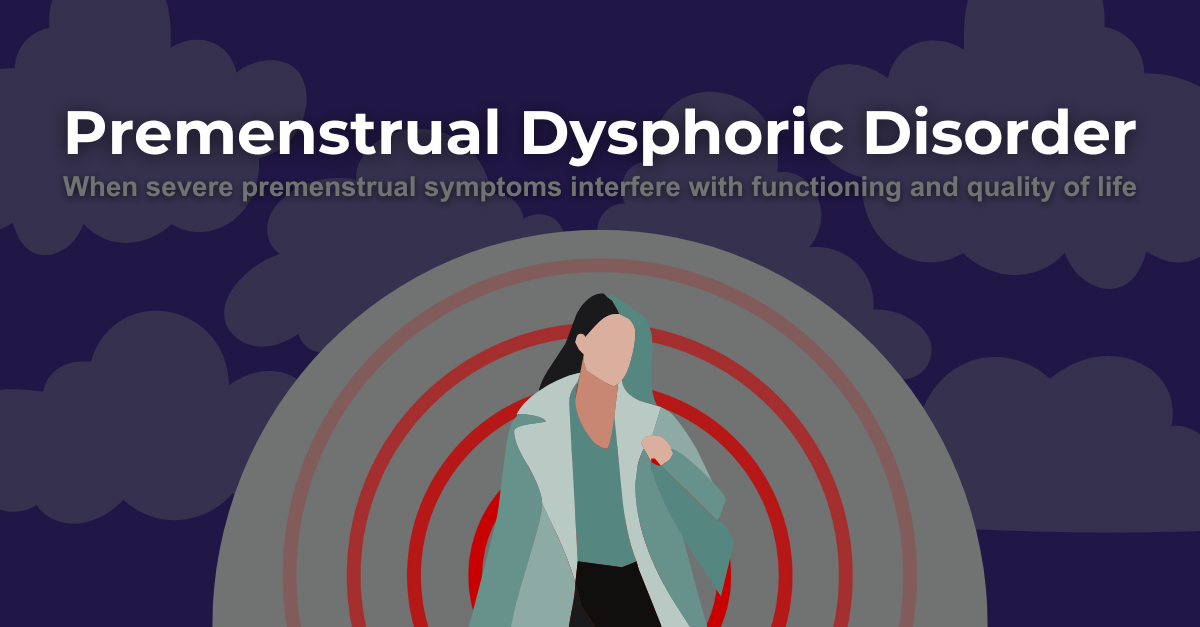August 31st, 2022

While most are acquainted with the term PMS or Premenstrual Syndrome, Premenstrual Dysphoric Disorder may be more unknown to the vast majority. The Mayo Clinic defines Premenstrual Dysphoric Disorder (PMDD) as a “severe, sometimes disabling extension of premenstrual syndrome (PMS).” Though the familiar PMS may be common in women of childbearing age and create mild symptoms, PMDD is a more severe set of symptoms that may require medical and psychological treatment.
Yes. While there is an abundance of similarities between the two, the primary clinical differences rest in the severity of symptoms. While PMS and PMDD symptoms appear similar, PMDD symptoms are more severe, chronic from month to month, and can impact daily functioning, relationships, and quality of life. PMS is a broad term that encompasses more mild symptoms that have been experienced in approximately 3 of every 4 menstruating women. Most women have experienced at least some of these symptoms at some point prior to beginning their period each month. PMS symptoms, though unpleasant, are generally considered mild and tolerable. However, the severity, combination, and frequency of these symptoms may vary or be entirely absent each month in PMS.
In comparison, PMDD symptoms are a more severe form of these psychological, physical, and behavioral symptoms that occur more consistently beginning in the 7-14 days prior to an expected period. PMDD statistics are lower, with only about 3-8% of women meeting the criteria for PMDD, though Cleveland Clinic puts this rate higher at 10% of women meeting diagnostic criteria for PMDD.
The Center for Women’s Mental Health at Massachusetts General Hospital in conjunction with Harvard Medical School breaks down PMDD symptoms into three categories: physical, psychological, and behavioral. It is important to remember that for a diagnosis of PMDD, symptoms from each category are observed. For an accurate diagnosis, you must be experiencing 5 of the following symptoms and at least one symptom from the psychological category:

If you are experiencing debilitating symptoms month to month with menstruation, you could be suffering from PMDD. Although there is no singularly conclusive test to show if someone is suffering from PMDD, there are ways to track symptoms. Experts in the field always recommend first ruling out other physical diseases and psychological diagnoses. Many women may experience an increase in severity of previously identified mood and anxiety disorders such as bipolar depression, depression, and anxiety during the premenstrual time. It is important to distinguish this premenstrual exacerbation (PME) from true PMDD. A major hallmark in the diagnosis of PMDD is the cyclical nature of symptoms. Women suffering from PMDD will see symptoms arise in the 7-14 days prior to menstruation or the luteal phase and then will have a reprieve of symptoms several days after menstruation begins. The best way to accurately assist your healthcare provider in diagnosing PMDD is to track symptoms experienced daily with a menstrual log.
Unfortunately, researchers are unable to pinpoint one underlying cause of PMDD and indicate this disorder could be due to a number of factors. As is well known, during menstrual cycles, hormone levels fluctuate. PMDD symptoms are seen during the luteal phase of the menstrual cycle, or at the end of the cycle when levels of estrogen and progesterone are decreasing. It is not an abnormal level of hormones that causes PMDD, but rather your body’s specific sensitivity to the hormonal changes occurring monthly. Also fluctuating during the menstrual cycle is the body’s level of serotonin. Serotonin is the neurotransmitter that helps to control mood as well as appetite, sleep, and other important aspects of health.
You are at a higher risk of PMDD if you have pre-existing anxiety or depression, a family history indicative of PMDD, smoke, or are in poor health. The crux of this information (or lack of clear cause) is to say that PMDD is not a choice or behavioral issue, but likely an issue related to biology. Specifically, how your body abnormally deals with a normal fluctuation in hormones and neurotransmitters throughout the menstrual cycle.

While there is no cure, there are effective treatment options to consider after a diagnosis of PMDD! These treatments stem from a wide variety of methodologies including lifestyle changes, pharmacological interventions, and alternative medicine or holistic approaches. Consistent with any affective or mood disorder, exercise is vital to lower stress and naturally support serotonin levels in the brain. Experts generally put emphasis on aerobic types of exercise to combat symptoms. Stress management is also important in health and well-being and may have some effect on PMDD symptoms.
For this, seeking therapy from a licensed practitioner is always advised as a way to actively deal with symptoms and feelings around diagnosis. Cognitive Behavioral Therapy (CBT) has proven to be very effective in treating an assortment of mood disorders. Some have used changes in diet and increased protein while cutting out excessive amounts of caffeine, alcohol, and fatty or sugary foods. Experts have not agreed as to whether more holistic approaches such as taking vitamins like vitamin B6, magnesium, and calcium are clinically effective.
Studies have shown that Selective Serotonin Reuptake Inhibitors (SSRI’s or what we commonly think of as “antidepressants”) have been proven effective in the treatment of PMDD. Due to the intermittent nature of the PMDD symptoms, some doctors may suggest only taking SSRIs or an increased SSRI dose during the 2 weeks leading up to your period. This is called luteal phase dosing. Hormonal birth control may also help with symptoms.

PMDD is different than PMS in that symptoms are more severe and can cause disruption of daily life during the luteal phase of the menstrual cycle when symptoms emerge. While there is no definitive test for PMDD, it can be diagnosed by ruling out other imitating conditions and keeping a symptom log for several menstrual cycles. Treatments include lifestyle changes, holistic approaches and medication management to ease symptoms. Experts also recommend these treatments in conjunction with psychotherapy centering on a CBT approach.
Written by: Madison Barnes, LCSW.
At Clarity Clinic, we have highly trained staff who specialize in therapy and psychiatry services. To learn more about how we can support your mental health, call Clarity Clinic on (312) 815-9660 or schedule an appointment today.
Our Services
Virtual/Online CarePHP and IOPAdult PsychiatryChild & Adolescent PsychiatryAdult TherapyChild & Adolescent TherapyCouples CounselingFamily TherapyGroup TherapyPsychological TestingTranscranial Magnetic Stimulation (TMS)